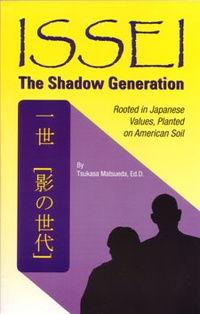Cherishing the values of the first generation of Japanese migrants to the United States of America, Tsukasa Matsueda, Ed.D. writes a compelling book that is simultaneously an honoring of the Issei and a message to younger generations.
Dr. Matsueda honors the Issei by recounting their history of struggle in the U.S.; He recapitulates the episodes of racism that they faced as they first took their part in U.S. society as cheap labor and then as a fictitious military threat during World War II. In order to get through these difficult times, the Issei relied in a system of values that lifted them above their obstacles. In the face of these obstacles, “[t]hey simply accepted life as it was with all its contradictions, confusion, absurdities, and mystery, but that did not mean that they never planned for the future or worked hard to reach their goals (Matsueda 2006: 71).” This ability to accept life for what it was, coupled with the values of enduring difficulties (gaman) and not giving up (makeruna) (pg. 39) provided the moral base from which the strong Japanese American community would emerge. However, more important than any value, “the single most important task in life was to do the best they could do for the sake of their children (kodomo no tame ni) (Matsueda 2006: 8).”
In leaving a message for the younger Japanese American generations, Matsueda reminds us of the values that made the Issei strong and praiseworthy. In an interview with the Japanese American National Museum, he writes: “I feel that the book would help the readers to either learn about the wonderful Issei legacy as I described it in the book and be proud to ‘introduce’ the Issei values to help the much divided American society...” Specifically, for the Japanese American younger generations, the legacy of the Issei is pertinent. In an era in which individualism is the norm, we must remember the spirit of collaboration that helped our communities endure arduous times. At the same time, while consumerism and the need for immediate satisfaction rule our lives, the legacy of the Issei reminds us of our debts and responsibilities to our parents, teachers and nature. While we must learn to appreciate the gifts given to us and never give up against the obstacles that this unpredictable life throws at us, we must also never forget to enjoy life itself. We must make the best of whatever life gives to us.
Matsueda compiles his experience and expertise to create this timely work of art. He was born in Stockton and spent the war years in the concentration camps at Rohwer, Arkansas and Tule Lake, California. He then served in the Military Intelligence Service. He is an educator, having taught at the University of Niigata, Japan, as well as the prestigious institutions of Stanford University and San Jose State University. With this distinguished background, Matsueda recounts the inspiring history and strength of the Issei. Having had years of conversation with the pioneers and having immersed himself in their words, he unearths the glorious character of the Shadow Generation and allows it to shine and light the path for younger generations.
Like a morning alarm, the Issei legacy rings through these pages, grabs the Americanized Japanese and reminds her/him what it is to be Japanese American. It warns us that while as individuals we have come a long way, we must preserve our sense of community. In the current social context, we are reminded that our perseverance as a community is not the result of our ability to assimilate. To assimilate would imply that that we give up our identity and our values. But rather, the great achievements of the Japanese American community have come through the ability to integrate new values and ideas to those that have made us who we are. Let us not forget the legacy of the Issei. Thus, Matsueda provides a window into ourselves to help us remember where we come from, and a solid foundation of history and values to guide us into the future.
This book will be delightfully refreshing for the Issei and Nisei, for whom it will be nice to see the ideological pillars that got our community this far not be lost in time. But more importantly, it is imperative that this book be read by the younger generations who are in danger of losing these lessons. Matsueda “...wanted the younger generation of J/A’s to know more about the Issei besides being ‘hard worker, but old fashioned and stubborn’.” The attempt here is to draw a picture of the Issei that illuminates the younger generations. It is an attempt to provide a grounding basis to understand ourselves as Japanese American individuals, as families, and as communities. This grounding basis are the values that were taught to us by the Issei. Thank you, Dr. Matsueda, for reminding us.
Let us not become like water in the melting pot. Let not our values simply evaporate in the face of assimilation.
* This article was originally published in the Japanese American National Museum Store online.
© 2007 Japanese American National Museum






